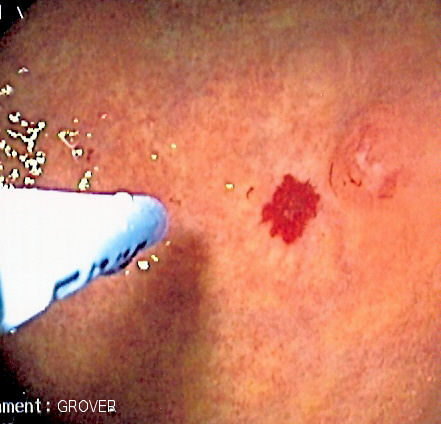Angiodysplasia: Difference between revisions
| Line 17: | Line 17: | ||
{{SK}} Colonic angiodysplasia; colonic arteriovenous malformation; vascular ectasia of the colon; angioectasia | {{SK}} Colonic angiodysplasia; colonic arteriovenous malformation; vascular ectasia of the colon; angioectasia | ||
==Therapy== | ==Therapy== | ||
Revision as of 13:56, 5 September 2012
For patient information click here
| Angiodysplasia | |
 | |
|---|---|
| An angiodysplasia in the colon being treated with argon plasma coagulation administered via probe through the colonoscope. The patient had multiple colonic angiodysplasiae in the setting of aortic stenosis. | |
| ICD-10 | K55.2 |
| ICD-9 | 569.84, 569.85 |
| DiseasesDB | 2963 |
| MeSH | D016888 |
|
Angiodysplasia Microchapters |
|
Diagnosis |
|---|
|
Treatment |
|
Case Studies |
|
Angiodysplasia On the Web |
|
American Roentgen Ray Society Images of Angiodysplasia |
Editor-In-Chief: C. Michael Gibson, M.S., M.D. [1]
Synonyms and keywords: Colonic angiodysplasia; colonic arteriovenous malformation; vascular ectasia of the colon; angioectasia
Therapy
If the anemia is severe, blood transfusion is required before any other intervention is considered. Endoscopic treatment is an initial possibility, where cautery or argon plasma coagulation (APC) laser treatment is applied through the endoscope. Resection of the affected part of the bowel may be needed. However, the lesions may be widespread, making such treatment impractical. Embolisation through angiography is occasionally contemplated with severely bleeding lesions that cannot be visualised on colonoscopy.
If the bleeding is from multiple or inaccessible sites, systemic therapy with medication may be necessary. First-line options include the antifibrinolytics tranexamic acid or aminocaproic acid. Estrogens can be used to stop bleeding from angiodysplasia. Estrogens cause mild hypercoaguability of the blood. Estrogen side effects can be dangerous and unpleasant in both sexes. Changes in voice and breast swelling is bothersome in men, but older women often report improvement of libido and perimenopausal symptoms. (The worries about hormone replacement therapy/HRT, however, apply here as well.)
In difficult cases, there have been positive reports about octreotide[1] and thalidomide,[2]
In severe cases or cases not responsive to either endoscopic or medical treatment, surgery may be necessary to arrest the bleeding.
References
- ↑ Junquera F, Saperas E, Videla S, Feu F, Vilaseca J, Armengol JR, Bordas JM, Piqué JM, Malagelada JR (2007). "Long-term efficacy of octreotide in the prevention of recurrent bleeding from gastrointestinal angiodysplasia". Am. J. Gastroenterol. 102 (2): 254–60. doi:10.1111/j.1572-0241.2007.01053.x. PMID 17311647.
- ↑ Shurafa M, Kamboj G (2003). "Thalidomide for the treatment of bleeding angiodysplasias". Am. J. Gastroenterol. 98 (1): 221–2. doi:10.1111/j.1572-0241.2003.07201.x. PMID 12526972.